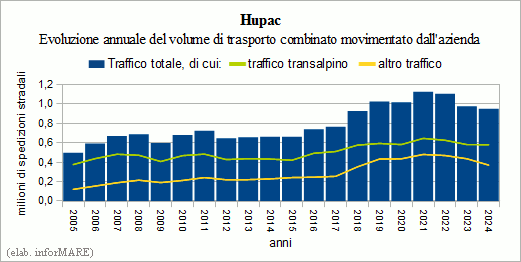
In 2024, the Swiss Hupac Group transported 949,000
Road shipments in combined road-rail transport, volume
which corresponds to a decrease of -2.6% on the previous year and is
equal to 1,818,000 TEU containers. Transportation services only
transalpine through Switzerland recorded a slight
Decrease of -0.2% despite capacity constraints
in the Gotthard Base Tunnel, while - announced today
the company - the interruption of the line via Modane and the adjustments
network in the north-east of Italy have led to a sharp decline in the
transalpine traffic through France and Austria. The
non-transalpine traffic with Western European markets,
and southeastern remained substantially
stable, with a slight decrease of -1.2%. Hupac explained that, "in addition to
cyclical decline in transport demand, the
Problems in the railway network are the main cause of a
traffic development below expectations".
Referring to the dysfunctions of the railway network,
Hupac CEO Michail Stahlhut noted
that "a deflection capacity of 80% is the
minimum necessary to prevent freight traffic from migrating to
the road. If the additional costs are considerable," he said
We expect the infrastructure manager to make
Concessions. After all, the current performance crisis is
the result of structural negligence and funding
of the past".
Recalling that on the occasion of the total closure of the railway
of the Rhine Valley in August 2024 for construction work
Hupac has launched a pioneering cooperation project
cross-border between France, Germany and Switzerland with the establishment of the
diesel shuttle through Alsace, which made it possible to
Bypass the line disruption with 20 freight trains per direction
and day, Stahlhut specified that "from the beginning
of 2025, a part of our transport between Belgium and Italy
it is conducted through France instead of Germany.
This allows us to reduce the risk of irregularities and
improve the reliability of our transport services".
As regards the measures deemed necessary to address the
disruptions to railway lines, Stahlhut explained that Hupac
recommends the creation of sidings along the
North-South corridor through Switzerland, e.g. in Basel,
Karlsruhe, Offenburg and Chiasso, which - he underlined - "measure
important to reduce the impact of disruptions and maintain the
traffic flow".
Referring then to the company's initiatives for the development of the
combined transport and specifying that at the heart of this strategy
there is the expansion of the capacity of the terminals in
Cooperation with partners, Hupac President Hans-Jörg
Bertschi, recalled that "for this year we expect
the opening of the new terminal in Piacenza and Barcelona,
which will be followed, next year, by the Milan terminal
Sorting". Bertschi also highlighted the need
to increase international cooperation to improve the
management of cross-border corridors which is a key factor in the
crucial for the future of intermodal transport in Europe:
"the joint commitment of Switzerland and Belgium to the corridor
North Sea-Rhine-Mediterranean goods - he noted - represents
a significant step forward. We expect further improvements
in corridor management, in particular better
coordination and high reliability of measurements
infrastructure, with a view to supporting the
modal shift policy towards the railway". For
Hupac, a concrete step in this direction would be the expansion
of the Antwerp-Metz-Basel corridor, which has been under discussion for some time, to a
profile of four meters.
